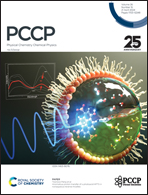Simultaneous switching of two different CO2-switchable amines in the same solution†
Abstract
Most CO2-responsive systems operate by using a base in water that is expected to be mostly deprotonated when under an atmosphere of air and mostly protonated under an atmosphere of CO2. This concept has led to the development of many different CO2-responsive materials such as solvents, polymers, surfactants, and solutes. As CO2-responsive materials research continues, more complex systems may be developed, including systems containing two different bases with different basicities. Understanding the influence each base has on the protonation equilibrium of the other base is important for designing systems in which effective deprotonation and protonation occur. This article presents a model that can predict the solution pH and the % protonation of two different bases at various concentrations under air and CO2. Experimental data was collected to demonstrate the successful simultaneous switching of two amines and to evaluate the accuracy of the predictive model. The simultaneous switching of two different CO2-switchable amines in the same solution was determined to be possible but only if the amine concentrations and basicities are within certain ranges, and only if the pKaH values of the two bases differ by no more than 3 units.

- This article is part of the themed collection: 2024 PCCP HOT Articles


 Please wait while we load your content...
Please wait while we load your content...